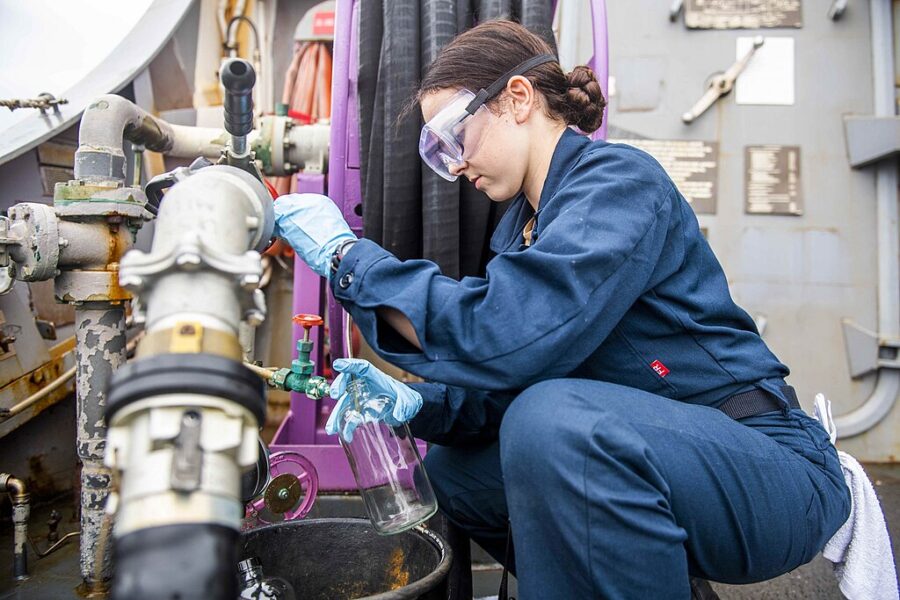federal government announces $1.1 billion in funding for ten-year cleaner fuels program to support local carbon fuels such as renewable diesel and...
Vous n'êtes pas connecté
- English
- Français
- عربي
- Español
- Deutsch
- Português
- русский язык
- Català
- Italiano
- Nederlands, Vlaams
- Norsk
- فارسی
- বাংলা
- اردو
- Azərbaycan dili
- Bahasa Indonesia
- Հայերեն
- Ελληνικά
- Bosanski jezik
- українська мова
- Íslenska
- Türkmen, Түркмен
- Türkçe
- Shqip
- Eesti keel
- magyar
- Қазақ тілі
- Kalaallisut ; kalaallit oqaasii
- Lietuvių kalba
- Latviešu valoda
- македонски јазик
- Монгол
- Bahasa Melayu ; بهاس ملايو
- ဗမာစာ
- Slovenščina
- тоҷикӣ ; toğikī ; تاجیکی
- ไทย
- O'zbek ; Ўзбек ; أۇزبېك
- Tiếng Việt
- ភាសាខ្មែរ
- རྫོང་ཁ
- Soomaaliga ; af Soomaali
 Maroc - TIMBERBIZ.COM.AU - A La Une - Hier 00:56
Maroc - TIMBERBIZ.COM.AU - A La Une - Hier 00:56
SA will lead the charge to a low-carbon fuel future
South Australia’s forest industries are poised to lead the charge toward a low-carbon fuel future, welcoming today’s announcement by the Federal Government of a $1.1 billion investment package to accelerate the development of low-carbon liquid fuels. Source: Timberbiz The package will support domestic cleaner fuel production for hard-to-abate sectors such as aviation, shipping, heavy transport, construction and mining. “The South Australian Forest Products Association acknowledges the Australian Government’s recognition of forestry residues as a key feedstock that can deliver renewable and sustainable fuel alternatives,” said Mr Nathan Paine, Chief Executive Officer of SAFPA. “Wood residues such as limbs and needles are often underutilised in the forestry sector. This investment represents a massive opportunity to convert those residues into renewable, sustainable alternative fuels that can power industries that are otherwise difficult to decarbonise.” At scale, forestry residue can be transformed into powerful low-emission fuels such as bio-methanol and Sustainable Aviation Fuel (SAF) – helping to decarbonise international air transport and shipping, both identified as priority industries in Australia’s net zero pathway. “This isn’t theoretical – HAMR Energy, a leader in low carbon liquid fuel is already advancing, with commercial outcomes only a few years away and with the potential for South Australia to host their first facility,” Mr Paine said. “Bioenergy is a low-carbon liquid fuel source that can both drive a net-zero economy and reduce the nation’s reliance on imported fuels, with the forestry sector already leading by example through investments in renewable energy and wood-waste utilisation.” South Australian-based company OneFortyOne is a clear example of the sector’s leadership in decarbonising the sector. As the operator of Australia’s largest sawmill, OneFortyOne use an alternative renewable biomass to power its operations, showcasing just how diverse the forestry sector is when it comes to decarbonisation. “As South Australia’s forest industries celebrate its 150th anniversary, our forest industries continue to supply the essential, foundational fibre that keeps the economy moving and homes being built,” Mr Paine said. “We’re not just a key part of achieving our net zero ambitions but we’re also a practical part of decarbonising South Australia’s energy and fuel systems.” The Federal Government’s package is designed to strengthen Australia’s energy security and position the nation as a global leader in sustainable fuels. According to Bioenergy Australia’s Securing Our Fuel Future report, even with electrification, Australia will require 30 billion litres of liquid fuel annually by 2050. Without local production, more than 80% of this demand would need to be imported. According to independent analysis produced by Deloitte for BioEnergy Australia as well as the CEFC has shown that a mature renewable fuel industry could: Generate $36 billion in economic activity by 2050. Reduce emissions by 230 million tonnes. Create more than 26,000 jobs, many in regional Australia. “South Australia’s forest industries are actively driving innovation and exploring new investments in renewable power, biomass technologies and clean fuels. “With the right policy settings, our sector can be at the heart of a new South Australian and national fuel industry, transforming residues into solutions that cut emissions, boost energy security and create jobs across the state,” Mr Paine said.
Articles similaires
Government pledges $1.1 billion over ten years to grow low-carbon liquid fuel industry
The federal government has announced funding budgeted at $1.1 billion “to help unlock the vast economic opportunities” offered by low-carbon...
Comment on Australia to invest $1.1 billion to unlock low carbon liquid fuels for jets, ships and machines by FarmerDave
I agree with Craig and Chris. These fuels may make a tiny, expensive contribution at the margin, but cannot go mainstream. The main reason is that the...
Weyerhaeuser joins ISFC
The International Sustainable Forestry Coalition (ISFC) has welcomed Weyerhaeuser, one of the world’s largest private owners of timberlands and one...
Labor to hand out $1.1bn in grants to boost production of low-carbon liquid fuels
Program aims to replace liquid fuels – which make up a third of Australia’s emissions – with cleaner alternatives made from canola, sorghum and...
Tasmanian timber awards its finest
From the forest to finished products, Tasmania’s forest and timber industries came together on Friday night to celebrate the outstanding...
Tasmanian timber awards its finest
From the forest to finished products, Tasmania’s forest and timber industries came together on Friday night to celebrate the outstanding...
Solar energy key to sustainable future of Ghana’s fishing sector — Fisheries Minister
The Minister for Fisheries and Aquaculture, Emelia Arthur, has underscored the role of solar energy in transforming Ghana rsquo;s fisheries sector and...
Forest Wind project in pine plantation canned
The proposed 1.2GW Forest Wind project, to be built within Australia’s largest exotic pine plantation between Gympie and Maryborough, has been...
Federal Govt pledges $1.1B towards low carbon fuels
A Mack tanker at a service station in Burpengary, QLD. Image: KRUTOPIMAGES/stock.adobe.comLow carbon liquid fuels are set to receive a $1.1 billion...
Les derniers communiqués
-
Evergreen Elevate Heads to Australia to Empower MSPs with Valuable Strategies and Insights on Better M&A Practices
Evergreen Elevate - 29/07/2025



